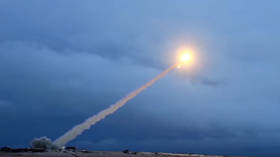Deep strikes by Ukraine and attack on Belarus would now trigger atomic response
Russian President Vladimir Putin has announced a series of updates to the national strategy for using nuclear weapons, intended to address the changing military and political situation and emergence of new threats.
“Today, the nuclear triad remains the most important guarantee of the security of our state and citizens, an instrument for maintaining strategic parity and the balance of power in the world,” Putin said.
Attack by a “non-nuclear state”
The first proposed update to the state policy “expands the category of states and military alliances” to which nuclear deterrence applies, and “supplements the list of military threats” intended to be neutralized by the deterrent.
This would treat “aggression against Russia by any non-nuclear state, but with the participation or support of a nuclear state” as their “joint attack,” crossing the nuclear threshold.
While no countries have been named, as written, this would clearly apply to Ukraine striking Russian territory with weapons supplied by the US or its nuclear NATO allies. Putin has previously said that such strikes would require active participation of foreign military personnel and assets, bringing them into direct conflict with Russia.
Lowering the nuclear threshold
The proposed revisions also “clearly state” the conditions under which Russia can proceed to employ atomic weapons, as “receipt of reliable information about a massive launch of air and space attack weapons and their crossing of our state border.”
Putin clarified that this means “strategic and tactical aircraft, cruise missiles, drones, hypersonic and other aircraft.” The mention of drones here is especially significant, as Ukraine has repeatedly launched mass UAV attacks against Russian strategic bases.
Expanding the umbrella to Belarus
For the first time, Russia has spelled out that its nuclear deterrent could be used in case of aggression against Belarus as well, as a member of the Union State. This includes a “critical threat to our sovereignty” through the use of conventional weapons, according to the proposal.
All of this has already been agreed with Minsk and President Alexander Lukashenko, Putin said on Wednesday.
What was the previous doctrine?
“reliable information” about the launch of ballistic missiles against itself and/or allies. Second, if a nuclear weapon or other kind of WMD was used against Russia and/or its allies. Third, if an enemy acted against “critical state or military facilities” that could disrupt the response of Russian nuclear forces. And fourth, if Russia comes under conventional attack that would “threaten the very existence of the state.”
Why were the changes proposed now?
“too general” and said that Western “ignorance” requires Russia to say “more clearly, more distinctly, more definitely what could happen” if they continued their “unacceptable and escalatory actions.”
Since May, the government in Kiev has clamored for the US and its allies to remove all restrictions on use of their weapons against Russia, which Moscow has clearly said would represent direct Western involvement in the conflict.
“extreme measure” to protect Russian sovereignty, but that Moscow must take into account that the “modern military-political situation is changing dynamically… including the emergence of new sources of military threats and risks for Russia and our allies.”
You can share this story on social media:
Follow RT on 












